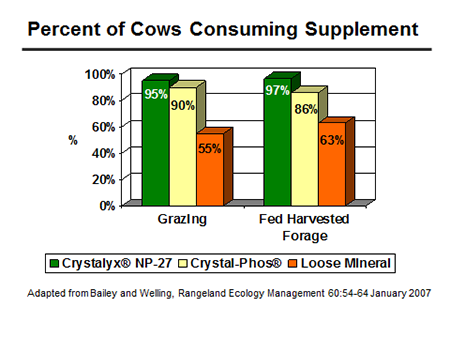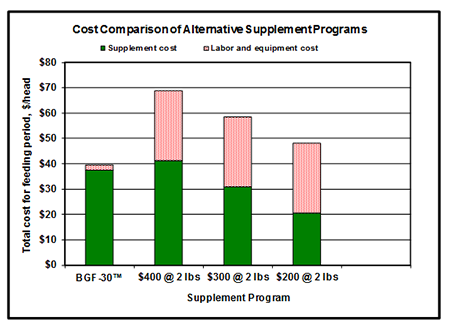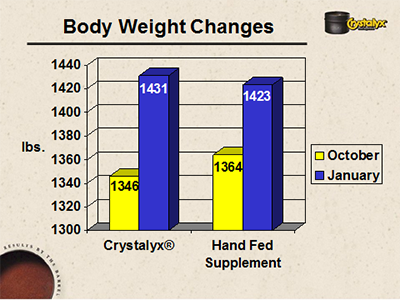It’s often mentioned that a key benefit or the #1 job description of CRYSTALYX® is to improve forage utilization, especially of low quality forage (low protein and high fiber content). This is true and its one of the reasons cattle and CRYSTALYX® work so well together. Cows can digest forage and CRYSTALYX® can help them do it much more efficiently; up to 20% better in some of our past studies.
Self-fed mineral supplementation: Try it the CRYSTALYX way
One of my early feed career mentors, Mick Lovelace, was famous for teaching me and several colleagues I still work with today the value of mineral supplementation. It wasn’t the importance of mineral nutrition that Mick taught but rather the importance of consistent and predictable intake with self-fed supplements. One of his favorite sayings was, “there’s two ways to supplement cattle, our way or the wrong way.” While this is definitely a biased statement and overlooking lots of good products, the take home message he was conveying was that a mineral program, no matter how good it looks on paper, isn’t worth anything if intake is improper or management is lacking.
What's in a lick of CRYSTALYX?
CRYSTALYX® is a supplement in the market that we often refer to as value added. There are a lot of different definitions to value added. A text book definition from Feeds and Feeding 101 may read something like this: “taking commodity ingredients and changing the makeup to be something much better where the sum is greater in value than the parts.” Another simpler definition and one a customer using CRYSTALYX® would expect is “give me something I can use that’s valuable and makes my operation just a little (or a lot) better. “
CRYSTALYX and cold weather
Welcome to January 2014! I was traveling last week in a part of the U.S. that was affected by winter weather. While I don’t want to downplay the added stress severe cold can cause, I was somewhat amused by the media’s coverage of what most of us in the Ag world understand as simply “Winter,” and not necessarily “Polar Vortex.”
The real value of CRYSTALYX: It goes beyond price and the price of alternative feeding methods
Several recent blogs have mentioned the fundamental values of CRYSTALYX® supplementation. Topics on the value of getting cattle in better shape for winter, utilizing forages more effectively and efficiently, calf weaning and health, and raising replacement heifers. Supplementation definitely pays, more so now than ever with the value of feeder, fat, and replacement cattle.
Frequency of supplementation: CRYSTALYX has the advantage
The frequency of supplementation to beef cattle grazing pasture or being fed hay has a lot of ongoing commentary. There’s good research on this topic dating back a few decades, and more recently with range beef cattle in Oregon (Schauer et al., 2005; Bohnert et al., 2002). Many metabolism studies comparing the efficiency of the strategies of daily supplementation compared to alternate days or even weekly intervals have been conducted. Much of this current data has concluded that cow performance related to body condition score was not negatively impacted by the frequency of supplementation, nor were other parameters such as dry matter intake digestibility or grazing duration. Some conclusions were based on the fact that ruminants can recycle Nitrogen from protein supplementation rather efficiently and maintain adequate levels in their body to support protein needs during periods of infrequent supplementation.
Producers and suppliers alike: Know your supplement
When CRYSTALYX® first started the blog more than 2 years ago, one of the first topics I “blogged” about was supplement value. I like to draw attention to value and to topics that differentiate supplements when the feeding season begins. After all, it is September and many fall and winter supplement programs are being evaluated or started now.
When is the right time to start supplementing?
I get the above question a lot, and it’s usually followed up or preceded by, “okay, what should I supplement or what would you recommend.” The question actually leads to more questions, and is also a good reason to evaluate why we supplement our cattle and what are the benefits.
Cows in dry lot, it’s not a new concept: Where does CRYSTALYX fit?
There’s been a lot of renewed interest in the practicality and feasibility of managing beef brood cows in dry lot systems. There’s some University trial work, economic analysis, nutritional strategies, etc..., being discussed on how these systems may or may not fit. Recent effects of drought, commodity prices, and cash rent for pasture ground, and shrinking availability of pasture in the Corn Belt has been the main reason for this renewed interest. I say renewed because I do believe this practice really isn’t new and it’s not really a concept. It’s one way to cope with drought, and was likely more common place historically when every farm had 20 beef cows, a few sows, chickens, and a dozen milk cows. I can still find a spot or two in my travels where beef cows are managed in dry lot year round and the subsequent calving season is year round as well.
Where would we be now had it not been for CRYSTALYX?
Several CRYSTALYX® blogs have been topics surrounding “volatility” in our business and how it is more or less the norm these days. I think the weather we’ve had in the past couple of years could be summarized much the same. From floods to drought to extreme heat and cold and late spring blizzards, it reminds me of a common saying I here almost everywhere I travel, “we sure have had a weird ____ “ (fill in the blank and pick your season of year).




